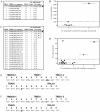Genetic and structural basis for selection of a ubiquitous T cell receptor deployed in Epstein-Barr virus infection
- PMID: 21124993
- PMCID: PMC2987824
- DOI: 10.1371/journal.ppat.1001198
Genetic and structural basis for selection of a ubiquitous T cell receptor deployed in Epstein-Barr virus infection
Abstract
Despite the ∼10(18) αβ T cell receptor (TCR) structures that can be randomly manufactured by the human thymus, some surface more frequently than others. The pinnacles of this distortion are public TCRs, which exhibit amino acid-identical structures across different individuals. Public TCRs are thought to result from both recombinatorial bias and antigen-driven selection, but the mechanisms that underlie inter-individual TCR sharing are still largely theoretical. To examine this phenomenon at the atomic level, we solved the co-complex structure of one of the most widespread and numerically frequent public TCRs in the human population. The archetypal AS01 public TCR recognizes an immunodominant BMLF1 peptide, derived from the ubiquitous Epstein-Barr virus, bound to HLA-A*0201. The AS01 TCR was observed to dock in a diagonal fashion, grasping the solvent exposed peptide crest with two sets of complementarity-determining region (CDR) loops, and was fastened to the peptide and HLA-A*0201 platform with residue sets found only within TCR genes biased in the public response. Computer simulations of a random V(D)J recombination process demonstrated that both TCRα and TCRβ amino acid sequences could be manufactured easily, thereby explaining the prevalence of this receptor across different individuals. Interestingly, the AS01 TCR was encoded largely by germline DNA, indicating that the TCR loci already comprise gene segments that specifically recognize this ancient pathogen. Such pattern recognition receptor-like traits within the αβ TCR system further blur the boundaries between the adaptive and innate immune systems.
Conflict of interest statement
The authors have declared that no competing interests exist.
Figures





Similar articles
-
T cell receptor repertoire for a viral epitope in humans is diversified by tolerance to a background major histocompatibility complex antigen.J Exp Med. 1995 Dec 1;182(6):1703-15. doi: 10.1084/jem.182.6.1703. J Exp Med. 1995. PMID: 7500015 Free PMC article.
-
CDR3α drives selection of the immunodominant Epstein Barr virus (EBV) BRLF1-specific CD8 T cell receptor repertoire in primary infection.PLoS Pathog. 2019 Nov 25;15(11):e1008122. doi: 10.1371/journal.ppat.1008122. eCollection 2019 Nov. PLoS Pathog. 2019. PMID: 31765434 Free PMC article.
-
Epstein-Barr Virus Epitope-Major Histocompatibility Complex Interaction Combined with Convergent Recombination Drives Selection of Diverse T Cell Receptor α and β Repertoires.mBio. 2020 Mar 17;11(2):e00250-20. doi: 10.1128/mBio.00250-20. mBio. 2020. PMID: 32184241 Free PMC article.
-
Some lessons from the systematic production and structural analysis of soluble (alpha)(beta) T-cell receptors.J Immunol Methods. 2009 Oct 31;350(1-2):14-21. doi: 10.1016/j.jim.2009.08.008. Epub 2009 Aug 26. J Immunol Methods. 2009. PMID: 19715696 Review.
-
Big Data Science on T Cell Receptor-mediated Immune Regulation.JMA J. 2025 Apr 28;8(2):338-344. doi: 10.31662/jmaj.2024-0304. Epub 2025 Mar 21. JMA J. 2025. PMID: 40416013 Free PMC article. Review.
Cited by
-
Grouping T-Cell Antigen Receptors by Specificity.Methods Mol Biol. 2022;2574:291-307. doi: 10.1007/978-1-0716-2712-9_15. Methods Mol Biol. 2022. PMID: 36087209 Free PMC article.
-
The T cell antigen receptor: the Swiss army knife of the immune system.Clin Exp Immunol. 2015 Jul;181(1):1-18. doi: 10.1111/cei.12622. Epub 2015 May 14. Clin Exp Immunol. 2015. PMID: 25753381 Free PMC article. Review.
-
A framework for highly multiplexed dextramer mapping and prediction of T cell receptor sequences to antigen specificity.Sci Adv. 2021 May 14;7(20):eabf5835. doi: 10.1126/sciadv.abf5835. Print 2021 May. Sci Adv. 2021. PMID: 33990328 Free PMC article.
-
Naive CD8⁺ T-cell precursors display structured TCR repertoires and composite antigen-driven selection dynamics.Immunol Cell Biol. 2015 Aug;93(7):625-33. doi: 10.1038/icb.2015.17. Epub 2015 Mar 24. Immunol Cell Biol. 2015. PMID: 25801351 Free PMC article.
-
T-cell receptor-β V and J usage, in combination with particular HLA class I and class II alleles, correlates with cancer survival patterns.Cancer Immunol Immunother. 2018 Jun;67(6):885-892. doi: 10.1007/s00262-018-2139-7. Epub 2018 Mar 5. Cancer Immunol Immunother. 2018. PMID: 29508024 Free PMC article.
References
-
- Macsween KF, Crawford DH. Epstein-Barr virus-recent advances. Lancet Infect Dis. 2003;3:131–140. - PubMed
-
- Khan N, Hislop A, Gudgeon N, Cobbold M, Khanna R, et al. Herpesvirus-specific CD8 T cell immunity in old age: cytomegalovirus impairs the response to a coresident EBV infection. J Immunol. 2004;173:7481–7489. - PubMed
-
- Trautmann L, Labarriere N, Jotereau F, Karanikas V, Gervois N, et al. Dominant TCR V alpha usage by virus and tumor-reactive T cells with wide affinity ranges for their specific antigens. Eur J Immunol. 2002;32:3181–3190. - PubMed
Publication types
MeSH terms
Substances
Grants and funding
LinkOut - more resources
Full Text Sources
Molecular Biology Databases
Research Materials

